
by Dave Packer, Marine Ecologist, NOAA Fisheries/Northeast Fisheries Science Center/James J. Howard Marine Sciences Laboratory
Michelle Bachman, Fishery Analyst for Habitat, New England Fishery Management Council
September 11, 2019
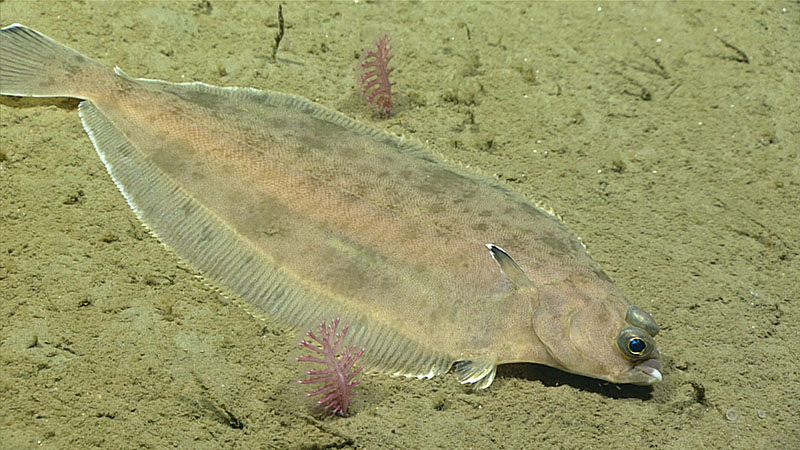
A flounder among sea pens, as seen during the third dive of Deep Connections 2019. Image courtesy of the NOAA Office of Ocean Exploration and Research. Download larger version (jpg, 1.3 MB).
While the exploration of the deep sea can and should be undertaken for its own sake, it is important to remember that the data we collect can become essential components used by resource managers.
A perfect example of this involves deep-sea coral and sponge habitats off the Northeast U.S. coast and the commercially important fisheries that occur within them. Deep-sea coral and sponges are complex living features that provide important three-dimensional structure in many seafloor communities, and have been identified as habitat for several commercial species. They can be important hotspots of biodiversity in the deep ocean, and their vulnerability to human impacts has stimulated research, monitoring, mapping, and conservation efforts.
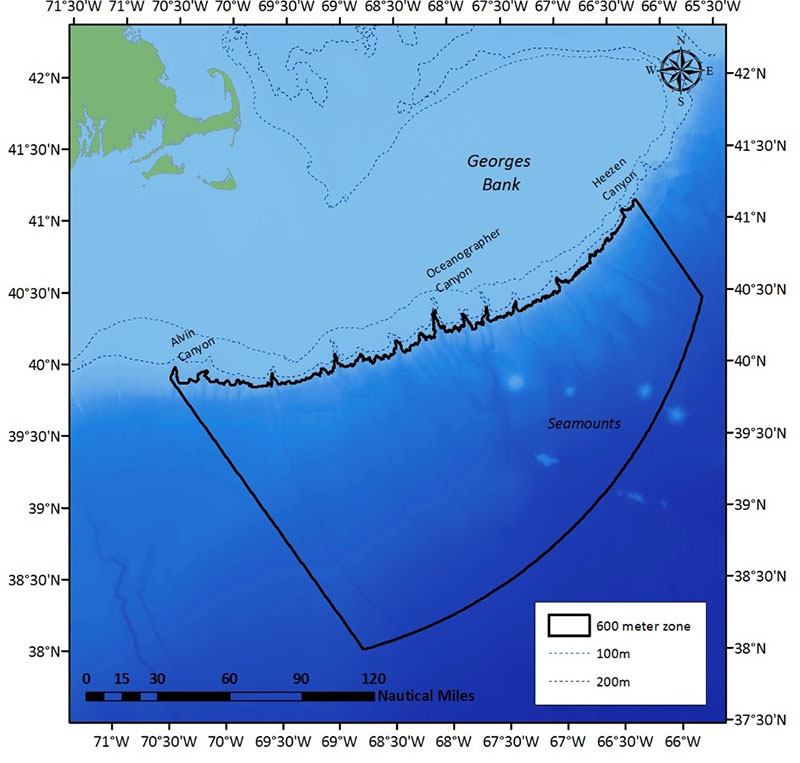
The NEFMC approved 600 meter minimum depth broad zone to protect deep-sea corals south of Georges Bank, which extends out to the 200 mile U.S. E.E.Z. limit. Four seamounts and 20 submarine canyons are protected within the zone. Oceanographer, as well as Gilbert and Lydonia Canyons and the seamounts are also within the Northeast Canyons and Seamounts Marine National Monument. Alvin Canyon is roughly the boundary between the NEFMC and MAFMC regions. Heezen Canyon is near the Canadian border. The Gulf of Maine deep-sea coral management areas are not shown. Image courtesy of the New England Fishery Management Council. Download larger version (jpg, 360 KB).
The 2007 Magnuson Stevens Fishery Conservation and Management Act (MSA) provides a mechanism by which to protect deep-sea corals. Fisheries in Federal waters are primarily managed by NOAA Fisheries under the jurisdiction of regional Fishery Management Councils. In the Northeast Region, this includes the New England and Mid-Atlantic Fishery Management Councils. The MSA gives the Councils discretionary authority to designate protection zones and implement measures to protect deep-sea corals from the impacts of fishing gear.
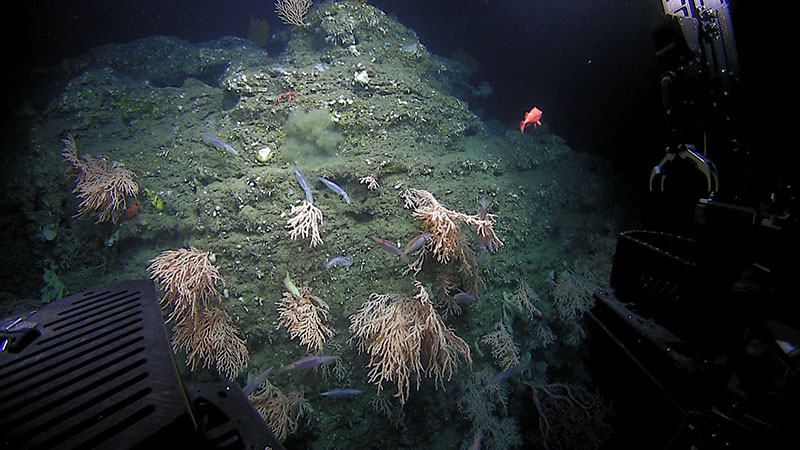
Shortfin squid swim among a cluster of corals during the fifth dive of Deep Connections 2019. Image courtesy of the NOAA Office of Ocean Exploration and Research. Download larger version (jpg, 1 MB).
Since 2012, several research vessels, including NOAA Ship Okeanos Explorer, have mapped and surveyed the seafloor off the Northeast continental shelf, with expedition plans often designed to address Council needs and priorities relating to deep-sea corals. Mapping the seafloor helps determine where deep-sea coral habitats are likely to occur by providing data for predictive deep-sea coral habitat suitability models. The images from camera platforms like the remotely operated vehicle (ROV) Deep Discoverer are used to determine the spatial distribution of deep-sea corals in relation to environmental parameters, as well as in relation to associated species, especially commercially important species. All this data, including seafloor mapping, coral distributions, and habitat suitability models, supported the recent creation of deep-sea coral protection zones by both the New England and Mid-Atlantic Fishery Management Councils.
This science and management partnership led to the first use of the MSA deep-sea coral discretionary authority in 2016, when the Mid-Atlantic Fishery Management Council created the Frank R. Lautenberg Deep-Sea Coral Protection Area. It covers more than 38,000 square miles from New York to Virginia on the outer continental shelf. Deep-sea explorations were also instrumental in the 2016 designation of the Northeast Canyons and Seamounts Marine National Monument off New England. Finally, in 2017-2018 the New England Fishery Management Council designated a 25,153 square mile coral management zone encompassing the slope, canyons, and seamounts off New England, plus three smaller zones in the Gulf of Maine. This action is awaiting NOAA Fisheries approval and should be effective early in 2020.
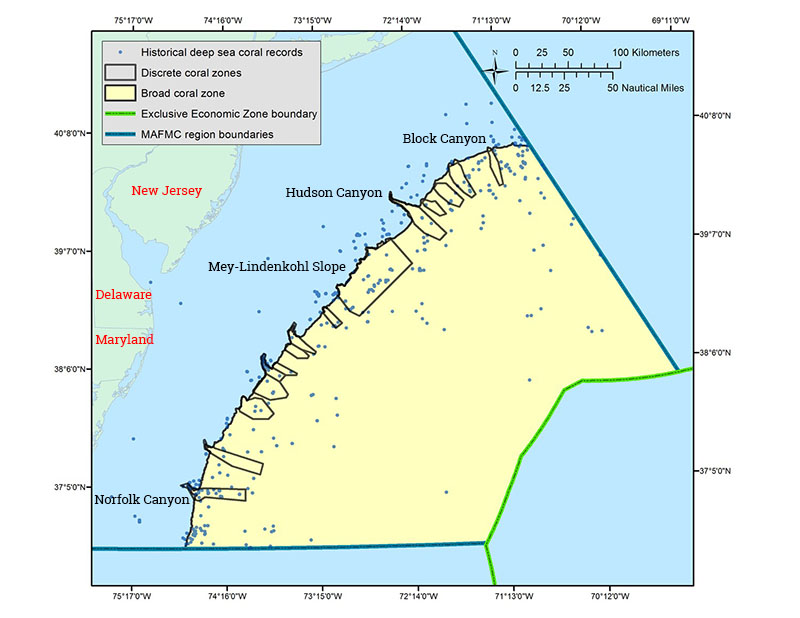
The Frank R. Lautenberg Deep-sea Coral Protection Area in the mid-Atlantic. ‘Discrete’ zones protect defined areas of canyons and canyon complexes based on known coral distributions or outputs of predictive models that rank the likely presence of suitable coral habitats. The ‘broad’ zone protects a large area of deepwater habitats extending from approximately 450 meter depth on the slope out to the 200 mile U.S. boundary limit (E.E.Z.). The objective is to protect corals by limiting future expansion of bottom fishing in an area that is largely outside the footprint of current fishing activity. Image courtesy of the Mid-Atlantic Fishery Management Council. Download larger version (jpg, 522 KB).
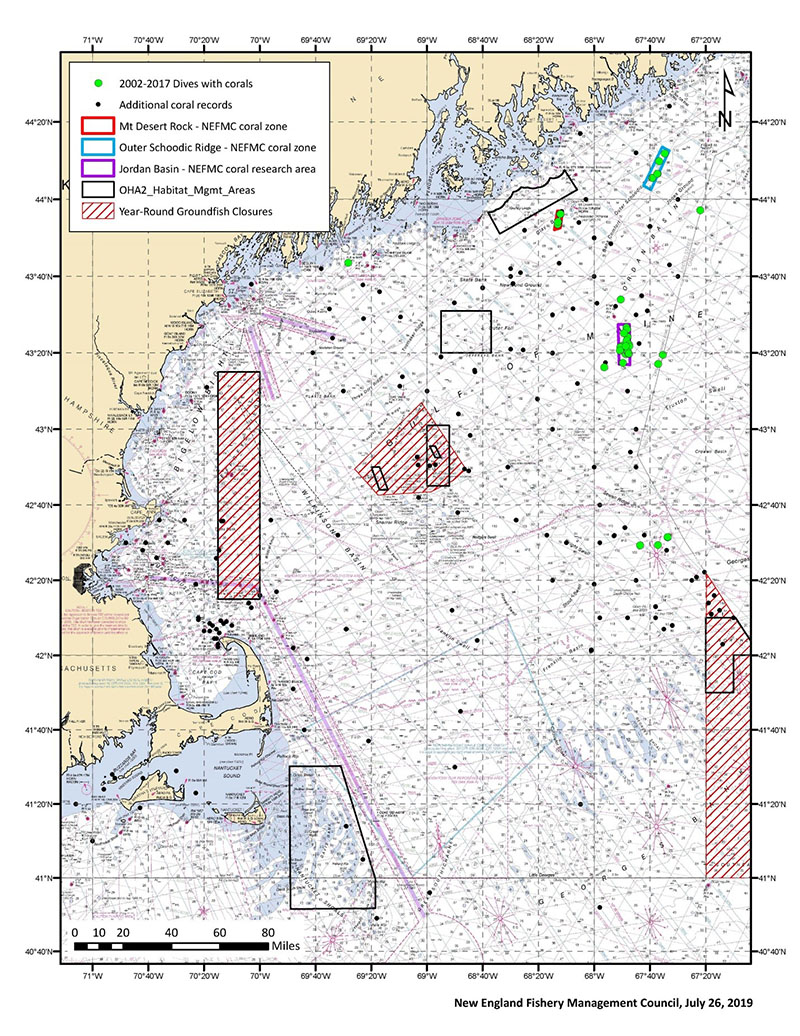
Locations of deep-sea coral management areas, coral location records, and fishery management areas in the Gulf of Maine. Floating wind farms are being considered in this region, and understanding coral occurrence and distribution while avoiding those habitats during spatial planning for wind energy will be very important in the future. Image courtesy of the New England Fisher Management Council. Download larger version (jpg, 2 MB).
Deep-sea explorations are useful not only to regional fishery management councils, but also support state and federal discussions about potential offshore energy development. Furthermore, deep-sea explorations can provide important insights into past, present, and future geohazards, such as submarine landslides. Thus, deep-sea exploration has practical applications in resource management, while also increasing our general understanding of the deep sea, which represents the largest portion of our planet.
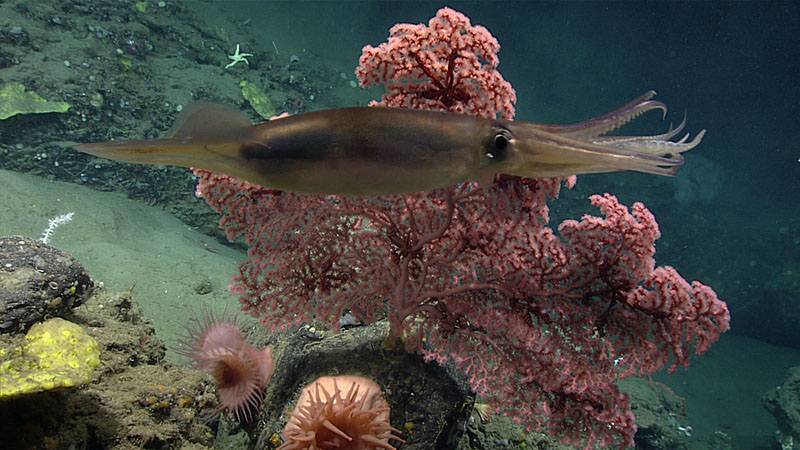
A shortfin squid swims by a large coral during a dive on Kinlan Canyon, the sixth dive site of Deep Connections 2019. Image courtesy of the NOAA Office of Ocean Exploration and Research. Download larger version (jpg, 1.2 MB).